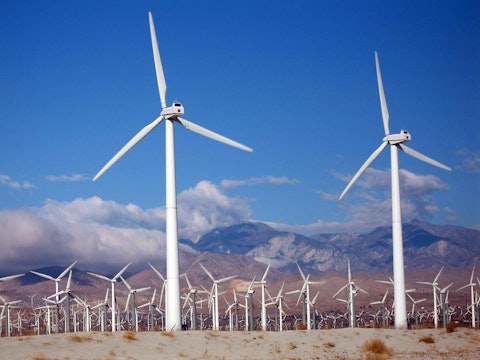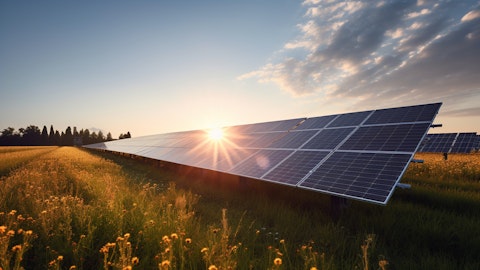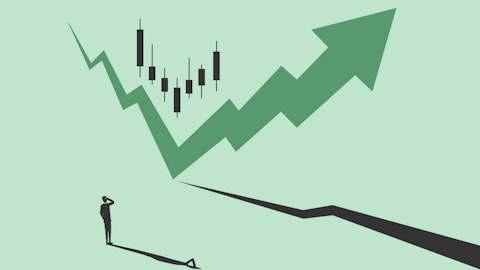In this article, we shall discuss the 30 countries with the cleanest air in the world. To skip our detailed analysis of the renewable energy sector in 2023, go directly and see 5 Countries with the Cleanest Air in the World.
As the climate crisis exacerbates globally, governments, especially from countries with the cleanest air in the world, are diverting greater focus towards achieving net-zero carbon emission targets by 2050. However, according to an analysis by McKinsey and Company, achieving these goals will necessarily require greater investment in electricity generation via renewable energy sources. However, according to Deloitte, in 2022, renewable energy growth was significantly hampered in the US, which is one of the countries with the cleanest air in the world, due to rising costs and project delays, which in turn were driven by global supply chain disruptions, skyrocketing inflation, increasing interest rates, glaring uncertainties in trade policies, and interconnection delays. Nevertheless, with the passage of the Inflation Reduction Act and increasing demand, robust growth within the renewable energy industry is expected in 2023. Some of the largest players in the renewable energy sector which are likely to be affected by these trends are NextEra Energy Inc. (NYSE:NEE), General Electric Co. (NYSE:GE), and Plug Power Inc. (NASDAQ:PLUG). To delve into further detail about the global clean energy sector in 2023, check out our coverage of the 11 Most Undervalued Renewable Energy Stocks To Buy According To Hedge Funds.
Within the next decade, a report by McKinsey estimates that global renewable energy capacity will drastically increase to more than 8,800 gigawatts. Of this, the vast majority will be derived from onshore wind and solar power. However, the report also points out that additional solar panels and onshore wind turbines will require substantial land space, the overall implications of which are ominous. Developers will need to continuously identify new sites at a time when the availability of suitable, economically desirable land is dire. Further constraints that are likely to hamper the growth of the global renewable energy sector are different regulatory and sustainability limits, the upsurge in land prices globally, long and unpredictable development timelines, and increased grid congestions.
Clean Energy Transition in the Oil and Gas Industry: An Analysis
Since the burning of fossil fuels like oil and gas is one of the greatest sources of carbon emissions and with climate change assuming a higher priority for countries with the cleanest air in the world, efforts to impose a sustainable transition to a lower-carbon energy model are underway and require fundamental shifts in how energy is produced and consumed globally. These shifts require strategic adjustments by businesses. According to an article by McKinsey, oil and gas companies which have long relied on fossil fuels for electricity generation are not spared from this global transition and find themselves needing to navigate an environment in which incredibly strict carbon-reduction targets are likely to impact investment decisions. However, the oil and gas industry is still largely uncertain about where to support initiatives like offshore generation, EV charging, and hydrogen production and development. As a result, operating models for new and legacy companies are undergoing drastic transformations in the face of competition from companies like NextEra Energy Inc. (NYSE:NEE), General Electric Co. (NYSE:GE), and Plug Power Inc. (NASDAQ:PLUG).
According to McKinsey’s Global Energy Perspective 2022, fossil fuels like oil and natural gas are widely projected to sustain a significant share of the energy mix at least till 2050, partly due to their methods of combining affordability and security of supply. Regardless, the report still postulates that the oil and gas industry is adequately positioned to play a meaningful role in the global energy transition effort. Some of the main reasons for this are their massive global footprint, the risk appetite of their investors, their expansive balance sheets and cash positions, and their long-standing relationships with energy consumers and stakeholders. A quick analysis of how strategic choices can aid in the implementation of a sustainable power value chain reveals three primary ways oil and gas companies can lead in the global energy transition effort.
One of the primary ways in which they can do this is by constructing an operational model whereby customer centricity is at the core. Business models tend to constantly evolve as innovation shapes technology and services landscapes worldwide. Oil and gas companies can leverage their existing business and deep technical capabilities to aid in creating value in key segments of the energy transition, all the while creating specific and integrated customer offerings that are tailored to individual requirements. This customer centric approach ensures oil and gas players enter production when demand is rising, invest capital in projects best suited to consumer needs, and help define a unique operating model. To know more about some of the measures the oil and gas industry is taking to reduce their carbon footprint substantially, check out our article on Top 20 Countries with the Highest Oil Consumption.
Secondly, the oil and gas sector must implement energy management and risk-exposure practices to contend with fluctuating prices, turbulent geopolitical circumstances and demand shocks. As a result, the industry has developed a robust and adaptable risk culture that continuously plays into investment decisions. Investors in renewables have already shown substantial tolerance to the risks of exposure to power markets, as evidenced by the 2021 Uri winter storm in the United States.
Thirdly, oil and gas companies need to offset geopolitical fluctuations by diversifying their product portfolios and optimize risk returns. Balancing risk exposure across entire portfolios can improve a company’s risk/return profile, compared with non-diversified portfolios. Furthermore, through diversified portfolios, companies can improve their project returns through higher leverage over countries with the cleanest air in the world.
Three Trends in the Renewable Energy Industry: An Overview
According to Deloitte, skyrocketing demand in 2023 could present serious problems for the growth of the renewable power industry through its exacerbation of supply chain disruptions and interconnection bottlenecks, thereby driving prices further up and extending project deadlines. Furthermore, clogs in the transmission belt could further hamper industry growth until capacity is substantially expanded. The report highlights three major evolving trends and opportunities that could help the industry navigate headwinds and increase growth in 2023, setting the stage for faster growth in 2024.
One primary trend that is instantly apparent is that rising clean energy component manufacturing could grease supply chain clogs over a short period of time. Currently, American manufacturing does not meet the renewable energy sector’s needs for clean energy components held up by sustainable domestic supply chains. Since then, the Inflation Reduction Act 2022 has exacerbated new plant announcements and has encouraged significant investment. This points towards a favorable environment for renewable energy companies in the longer term in countries with the cleanest air in the world.
Another trend that cannot be ignored is that new clean hydrogen economics could pave new pathways for renewable providers. The enactment of the Inflation Reduction Act in 2022 has ignited interest in green hydrogen. While lack of infrastructure makes hydrogen production unfeasible, policies driven by the Act could open doors for renewable energy companies like NextEra Energy Inc. (NYSE:NEE), General Electric Co. (NYSE:GE), and Plug Power Inc. (NASDAQ:PLUG) to benefit in 2023, causing investors to flock towards these stocks.
Lastly, an important sign that the renewable energy sector is maturing as an industry is that it is increasingly entering the scopes of different cyber attacks. With cyber threats projected to rise significantly in 2023, it is a good indicator that the clean energy transition is progressing, especially in countries with the cleanest air in the world.

Pixabay/Public Domain
Our Methodology
To compile our list of the 30 countries with the cleanest air in the world, we looked at the IQAir’s World Air Quality Report, which ranks countries based on their AQI (Air Quality Index) as of 2022. The AQI takes into account pollutants such as PM2.5 (particulate matter with a diameter of 2.5 micrometers or less), nitrogen dioxide (NO2), sulfur dioxide (SO2), carbon monoxide (CO), and ozone (O3) concentration levels. The higher the AQI value in a country, the greater the level of overall air pollution. For instance, an AQI value of 30 or below represents good air quality while an AQI value north of 300 represents hazardous air quality. We also looked at the Environment Protection Index by Yale University and the Global Green Economy Index (GGEI) to examine annual trends in air quality. We did this to account for seasonal variations, fluctuations and to validate our results. Subsequently, we selected 30 countries with the lowest AQI and ranked them from highest to lowest.
Many of the countries that feature in this list also feature on our list of the 5 Most Advanced Countries in Renewable Energy.
Countries with the Cleanest Air in the World
30. Switzerland
AQI: 10
The first entry in our list of the 30 countries with the cleanest air in the world is Switzerland. Switzerland’s electricity generation is largely dependent on sources of primary energy like wood and sunlight. Hydroelectric power constitutes for more than 45% of all electricity generation in Switzerland.
29. Ukraine
AQI: 9.7
Renewable sources like hydroelectric power, wind, and solar contributed to more than 30% of all electricity generation in Ukraine in 2021. There is an increased emphasis on electricity generation via solar power in Ukraine currently underway.
28. Japan
AQI: 9.1
More than 30% of Japan’s electricity is generated using renewable sources like geothermal power, wind, and solar energy. The Japanese government incentivizes companies to invest in renewable energy sources to minimize carbon emissions and meet net-zero targets.
27. Panama
AQI: 9
Hydroelectric energy is the main source of renewable energy in Panama. The country is also diverting major investments in solar energy and wind power.
26. United States of America
AQI: 8.9
The United States of America relies on multiple sources of renewable energy like hydroelectric, wind, and solar power for electricity generation. Although more than 40% of electricity production in the US is via natural gas, with the passage of bills like the Inflation Reduction Act, the country is moving towards cleaner energy production. Wind power is currently the largest source of renewable power in the US and generates more than 434 TWh of electricity annually.
25. Nicaragua
AQI: 8.9
Nicaragua has an abundance of renewable energy sources like biofuel, geothermal, and wind. 24.6% of all renewable energy in the country is generated using geothermal energy.
24. United Kingdom
AQI: 8.9
41.4% of United Kingdom’s electricity is generated using renewable energy sources. Wind power makes up for a large percentage of electricity production in the UK; other sources include ocean power, biofuels, solar, and geothermal.
23. Angola
AQI: 8.8
Angola’s main source of energy is hydropower, which contributes to its energy mix by 68%, followed by fossil fuels. The government is working towards sustainable projects to increase production of clean energy, causing Angola to feature on our list of the 30 countries with the cleanest air in the world.
22. Denmark
AQI: 8.6
In 2022, renewable energy sources contributed to generating more than 75% of Denmark’s electricity. The country’s renewable energy sources largely include wind, bioenergy, solar energy, and hydro power.
21. Cambodia
AQI: 8.3
Cambodia has multiple sources of renewable energy including hydropower, solar energy, and biomass. In 2021, 40% of Cambodia’s energy was generated through renewable sources.
20. Liechtenstein
AQI: 8.3
Liechtenstein generates a major percentage of its electricity domestically using renewable sources. Its main source of renewable energy comes from hydroelectric energy, followed by solar power.
19. Portugal
AQI: 8.1
In 2016, 28% of Portugal’s energy consumption was premised on renewable sources of energy. A diverse variety of renewable sources are used to generate electricity in Portugal, one of the most prominent being hydroelectric power, which contributed around 28% of the total electricity produced.
18. Costa Rica
AQI: 7.9
Costa Rica relies heavily on renewable energy sources to generate electricity. In 2016, 98.1% of its electricity was generated using renewable sources like hydro power, geothermal energy, wind energy, and solar power.
17. Argentina
AQI: 7.7
Electricity production in Argentina is mainly dependent on natural gas, which accounts for 57% of all energy produced in the country. However, the country is increasingly ramping up reliance on renewable sources of energy like hydropower, nuclear energy, wind energy, and solar energy.
16. Ireland
AQI: 7.5
Renewable energy sources in Ireland include wind power, solar power, and biomass. Wind is the largest contributor to the country’s renewable energy production due to an installed wind powerplant that catered to 31% of the country’s electricity needs in 2022.
15. Luxembourg
AQI: 7.4
In Luxembourg, 80% of electricity is generated using renewable sources of energy like hydropower, wind, biomass, and solar power, causing it to make our list of the 30 countries with the cleanest air in the world. Wind power constitutes 26% of total renewable energy production in the country.
14. Canada
AQI: 7.4
Canada is known to be a world leader in using energy from renewable sources, since 18.9% of its primary energy supply comes from renewable energy. Hydropower is its most important source and provides 59.3% of country’s electricity.
13. Bolivia
AQI: 7.3
The most important source of renewable energy in Bolivia is hydropower, followed by solar. The country is actively working towards changing its energy mix significantly and generating majority of electricity through renewable sources.
12. Suriname
AQI: 7
As of 2020, fossil fuel contributes by 52.9% in generating electricity in the Suriname. However, due to its low population, it has been able to make our list of the 30 countries with the cleanest air in the world.
11. Norway
AQI: 7
Norway is renowned as an ideal model for clean energy production for its heavy reliance on hydropower for much of its power production. Other sources of renewable energy in the country include wind power and thermal energy.
10. Sweden
AQI: 6.2
Sweden uses renewable energy sources like wind, solar, biomass, and geothermal for much of its energy production. In 2023, Sweden changed its renewable energy goals from ‘100% renewable’ to ‘100% fossil-free’, paving the way for more nuclear reactors to be built.
9. Belize
AQI: 5.6
Over the last two decades, Belize has invested highly in renewable energy sources. Currently more than half of the country’s electricity is produced via hydropower. Some other sources of renewable energy in the country include solar and biomass.
8. Andorra
AQI: 5.4
Andorra is actively moving towards meeting net zero targets by incorporating a consistent transition to renewable energy sources via numerous projects, including but not limited to the green hydrogen project.
7. Trinidad and Tobago
AQI: 5.1
Trinidad has multiple ongoing projects geared towards the production of different forms of renewable energy. The country aims to generate 30% of its electricity solely through renewable sources by 2030.
6. Finland
AQI: 5
Finland primarily relies on biomass as a source of renewable energy. Biomass accounts for more than 40% of all primary energy consumption. Other forms of renewable energy prevalent in the country include hydropower, wind, and solar. Finland is number 6 on our list of the 30 countries with the cleanest air in the world.
Click here to continue reading and see 5 Countries with the Cleanest Air in the World.
Suggested Articles:
- 15 Biggest Agricultural Companies in the US
- 10 Best Regional Bank ETFs
- 30 Best Places to Visit in Mexico that are Beautiful and Safe
Disclosure: None. 30 Countries with the Cleanest Air in the World is originally published on Insider Monkey.





